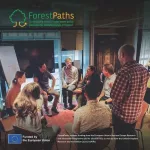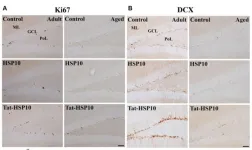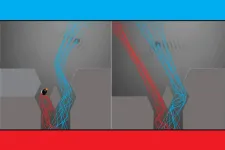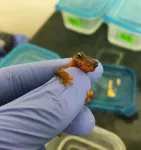(Press-News.org) University of Central Florida researcher Debashis Chanda, a professor at the NanoScience Technology Center, has developed a new technique to detect photons — elementary particles that span from visible light to radio frequencies and are instrumental in carrying cellular communication.
The advancement could lead to more precise and efficient technologies in various fields, from improving medical imaging and communication systems to enhancing scientific research and even potentially bolstering security measures.
Photon detection has typically relied on change/modulation of voltage or current amplitude. But Chanda has developed a way to detect photons by modulating the frequency of an oscillating circuit, paving the path for ultra-sensitive photon detection.
Chanda’s method uses a special, phase-change material (PCM) that changes its form when light touches it, making an electrical rhythm that stays steady, or a stable electrical circuit oscillation. When a light photon hits the material, it changes how fast the rhythm goes, or shifts the oscillation frequency. How much the rhythm changes depends on how strong the light is, similar to how a person’s voice changes the sound on the radio.
The new development was published recently in Advanced Functional Materials.
Long Wave Infrared (LWIR) detection in the 8 to 12 micrometer wavelength range is extremely important in astronomy, climate science, materials analysis and security. However, LWIR detection at room temperature has been a long-standing challenge due to the low energy of photons.
LWIR detectors that are currently available can be broadly categorized into two types: cooled and uncooled detectors, with both having their own limitations.
While cooled detectors offer excellent detectivity, they require cryogenic cooling — making them expensive and limiting their practical utility. On the other hand, uncooled detectors can operate at room temperature but suffer from low detectivity and slow response due to the higher thermal noise intrinsic to room temperature operation. A low-cost, highly sensitive, fast infrared detector/camera continues to confront scientific and technological challenges.
This is the main reason LWIR cameras are not widely used except in Department of Defense and space-specific applications.
“Unlike all present photon detection schemes where light power changes the amplitude of voltage or current (amplitude modulation — AM), in the proposed scheme hits, or incidents of photons, modulate the frequency of an oscillating circuit and are detected as a frequency shift, offering inherent robustness to noises, which are AM in nature,” Chanda says.
“Our FM-based approach yields an outstanding room temperature noise equivalent power, response time and detectivity,” Chanda says. “This general FM-based photon detection concept can be implemented in any spectral range based on other phase-change materials.”
“Our results introduce this novel FM-based detector as a unique platform for creating low-cost, high-efficiency uncooled infrared detectors and imaging systems for various applications such as remote sensing, thermal imaging and medical diagnostics,” Chanda says. “We strongly believe that the performance can be further enhanced with proper industry-scale packaging.”
This concept developed by the Chanda group provides a paradigm shift to high sensitive, uncooled LWIR detection as noise limits detection sensitivity. This result promises a novel uncooled LWIR detection scheme that is high sensitive, low cost, and can be easily integrated with electronic readout circuitry, without the need for complex hybridization.
The fundamental research is funded under a U.S. National Science Foundation grant #ECCS-2015722. The camera technology is under development with funding from Chanda’s Samsung Global Research Outreach Award 2022.
Licensing Opportunity?
The technology is patented. Find out more information about licensing this technology.
Researcher’s Credentials
Chanda has joint appointments in UCF’s NanoScience Technology Center, Department of Physics and CREOL, The College of Optics and Photonics. He received his doctorate in photonics from the University of Toronto and worked as a postdoctoral fellow at the University of Illinois at Urbana-Champaign. He joined UCF in Fall 2012.
END
UCF researcher discovers new technique for photon detection
The discovery could improve communications, medical imaging, security measures and more.
2023-12-12
ELSE PRESS RELEASES FROM THIS DATE:
Fat flies live longer on a diet at any age
2023-12-12
Old, obese flies get healthier and live longer if put on a diet, University of Connecticut researchers report on Dec. 8 in PNAS. If the effect holds true for humans, it would mean it’s never too late for obese people to improve their health with diet.
For way too many of us, eating too much goes along with getting old and a tendency to be obese. Different health organizations define obesity differently, but all agree it means having too much body fat, and is associated with a host of diseases related to metabolism including heart disease and diabetes. Many animal studies have shown that eating less—meaning sharply ...
European Policy Lab gathers stakeholders to map forest policy opportunities and barriers
2023-12-12
ForestPaths’ first Policy Lab convened stakeholders in Helsinki, Finland, on 27-29 September 2023. Nineteen carefully selected participants with diverse expertise – including research, policy, governance, civil society, value chain professionals, and forestry practitioners – engaged in discussions on forest-based policymaking and modelling related to climate change and biodiversity.
Tasked with considering policy actions given different timescales, governance paradigms, enablers, and barriers, participants contributed ...
Tat-heat shock protein 10 ameliorates age-related phenotypes in the hippocampus
2023-12-12
“Mitochondrial dysfunction is a major cellular change observed in the hippocampus during aging.”
BUFFALO, NY- December 12, 2023 – A new research paper was published in Aging (listed by MEDLINE/PubMed as "Aging (Albany NY)" and "Aging-US" by Web of Science) Volume 15, Issue 22, entitled, “Tat-heat shock protein 10 ameliorates age-related phenotypes by facilitating neuronal plasticity and reducing age-related genes in the hippocampus.”
In this new study, researchers Hyo Young Jung, Hyun Jung Kwon, Kyu ...
MIT researchers observe a hallmark quantum behavior in bouncing droplets
2023-12-12
In our everyday classical world, what you see is what you get. A ball is just a ball, and when lobbed through the air, its trajectory is straightforward and clear. But if that ball were shrunk to the size of an atom or smaller, its behavior would shift into a quantum, fuzzy reality. The ball would exist as not just a physical particle but also a wave of possible particle states. And this wave-particle duality can give rise to some weird and sneaky phenomena.
One of the stranger prospects comes from a thought experiment known as the “quantum bomb tester.” The experiment proposes that a quantum particle, such ...
Smoking causes brain shrinkage
2023-12-12
Smoking shrinks the brain, according to a study by researchers at Washington University School of Medicine in St. Louis. The good news is that quitting smoking prevents further loss of brain tissue — but still, stopping smoking doesn’t restore the brain to its original size. Since people’s brains naturally lose volume with age, smoking effectively causes the brain to age prematurely, the researchers said.
The findings, published in Biological Psychiatry: Global Open Science, help explain why smokers are at high risk of age-related cognitive decline and Alzheimer’s disease.
“Up until recently, scientists have overlooked ...
Mammogram rates increase when patients schedule themselves
2023-12-12
PHILADELPHIA— Having the ability to self-schedule mammograms was associated with a 15 percentage point increase following through with getting the screening, according to research from the Perelman School of Medicine at the University of Pennsylvania. The paper was published today in the American Journal of Preventive Medicine.
“Self-scheduling helps make the path to mammogram completion a little smoother, where you don’t have to find the time to call a scheduling line, wait on hold, or go back and forth trying to find an appointment that works for your schedule,” said the study’s lead author, Kimberly Waddell, ...
Protein study could one day advance Parkinson’s, breast cancer care
2023-12-12
PORTLAND, Oregon -- New research from Oregon Health & Science University could one day lead to therapies that prevent or treat diseases and infections tied to a protein that’s found in all human cells.
A study published today in the journal Molecular Cell describes how the protein ubiquitin is modified during a bacterial infection. The study details the steps taken to create a form of the protein known as lysine 6 polyubiquitin, where a long chain of ubiquitin molecules are linked through ...
Study exposes opportunities for strengthening cancer drugs trials in China
2023-12-12
More than one-eighth of the randomized trials of cancer drugs seeking regulatory approval in China in recent years used inappropriate controls to test the effectiveness and safety of the drugs, according to a new study published December 12th in the open access journal PLOS Medicine by Professor Xiaodong Guan of Peking University, China, and colleagues.
In randomized trials, patients are assigned to either a control arm, in which they receive the current optimal treatment, or an experimental arm, in which they receive the new drug being tested. However, studies have previously ...
Zapping manure with special electrode promises an efficient method to produce fertilizers, other chemicals
2023-12-12
MADISON – An interdisciplinary team led by University of Wisconsin–Madison scientists has developed a new technique that could help farmers extract useful nutrients such as ammonia and potassium from livestock manure to efficiently make fertilizer and other useful chemical products. While the strategy still needs to be scaled up beyond a proof-of-concept stage, the group's preliminary analyses show it could offer considerable benefits by cutting water and air pollution while simultaneously creating products that farmers could use or sell.
Manure stinks in part because it contains ammonia, one of the more ...
Novel early-detection method aims to stem disease spread in animal trade
2023-12-12
DENVER/Dec. 12, 2023 – A new article published in the journal Methods in Ecology and Evolution by Morris Animal Foundation-funded researchers describes a simplified method to detect a deadly fungus killing European salamanders. The ability to rapidly find the fungus is significant as the disease, although not detected in the U.S., could impact the millions of amphibians and salamanders annually imported.
The fungal pathogen Batrachochytrium salamandrivorans, or Bsal, threatens salamander diversity. Initially identified in northern Europe, evidence suggests it was introduced from Southeast Asia via the pet trade.
“The impacts of Bsal ...
LAST 30 PRESS RELEASES:
Fat tissue around the heart may contribute to greater heart injury after a heart attack
Jeonbuk National University researcher proposes a proposing a two-stage decision-making framework of lithium governance in Latin America
Chromatin accessibility maps reveal how stem cells drive myelodysplastic progression
Cartilaginous cells regulate growth and blood vessel formation in bones
Plant hormone allows lifelong control of proteins in living animal for first time
Swedish freshwater bacteria give new insights into bacterial evolution
Global measures consistently underestimate food insecurity; one in five who suffer from hunger may go uncounted
Hidden patterns of isolation and segregation found in all American cities
FDA drug trials exclude a widening slice of Americans
Sea reptile’s tooth shows that mosasaurs could live in freshwater
Pure bred: New stem cell medium only has canine components
Largest study of its kind highlights benefits – and risks – of plant-based diets in children
Synergistic effects of single-crystal HfB2 nanorods: Simultaneous enhancement of mechanical properties and ablation resistance
Mysterious X-ray variability of the strongly magnetized neutron star NGC 7793 P13
The key to increasing patients’ advance care medical planning may be automatic patient outreach
Palaeontology: Ancient tooth suggests ocean predator could hunt in rivers
Polar bears may be adapting to survive warmer climates, says study
Canadian wildfire smoke worsened pediatric asthma in US Northeast: UVM study
New UBCO research challenges traditional teen suicide prevention models
Diversity language in US medical research agency grants declined 25% since 2024
Concern over growing use of AI chatbots to stave off loneliness
Biomedical authors often call a reference “recent” — even when it is decades old, analysis shows
The Lancet: New single dose oral treatment for gonorrhoea effectively combats drug-resistant infections, trial finds
Proton therapy shows survival benefit in Phase III trial for patients with head and neck cancers
Blood test reveals prognosis after cardiac arrest
UBCO study finds microdosing can temporarily improve mood, creativity
An ECOG-ACRIN imaging study solves a long-standing gap in metastatic breast cancer research and care: accurately measuring treatment response in patients with bone metastases
Cleveland Clinic presents final results of phase 1 clinical trial of preventive breast cancer vaccine study
Nationally renowned anesthesiology physician-scientist and clinical operations leader David Mintz, MD, PhD, named Chair of the Department of Anesthesiology at the UM School of Medicine
Clean water access improves child health in Mozambique, study shows
[Press-News.org] UCF researcher discovers new technique for photon detectionThe discovery could improve communications, medical imaging, security measures and more.




